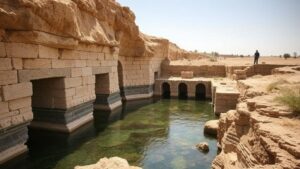Investigating the existence of Thinis, an ancient Egyptian city lost in historical texts.
Investigating the Existence of Thinis: An Ancient Egyptian City Lost in Historical Texts
The quest to uncover lost cities is a significant part of archaeological and historical research. Among these enigmatic locations lies Thinis, an ancient city that is often mentioned in historical texts but has yet to be definitively located on the modern map of Egypt. This article delves into the evidence surrounding Thinis, exploring its historical context, potential locations, and the implications of its existence on our understanding of early Egyptian civilization.
The Historical Context of Thinis
Thinis, or Thi-nit, is believed to have been a prominent city during the early Dynastic Period of Egypt, specifically around 3100 BCE. It is often cited as a key urban center, potentially serving as the capital of Upper Egypt before the unification of the Two Lands. Historical texts, particularly ancient writings, refer to Thinis as a seat of power and culture during a formative period of Egyptian history.
One significant source that mentions Thinis is the ancient historian Manetho, who wrote in the 3rd century BCE. Manetho described Thinis as a crucial city in the early history of Egypt, attributing to it the foundation of the first dynasty. This positions Thinis not only as a physical location but also as a symbol of early dynastic authority.
Potential Locations of Thinis
The exact location of Thinis has been a subject of much debate among historians and archaeologists. Various theories about Thinis geographical position have emerged, supported by different artifacts and site interpretations. Some of the most discussed theories include:
- The area near modern-day Nagada, which was a significant archaeological site and has yielded artifacts from the early dynastic period.
- The site of Abydos, known for its cemeteries of early kings and its importance in ancient Egyptian religion, is also suggested as a candidate for the location of Thinis.
- Evidence from nearby regions along the Nile River, which served as a crucial artery for trade and politics in ancient Egypt.
Each of these locations presents compelling arguments based on the archaeological record, further complicating the quest for Thinis. For example, the fact that Nagada housed significant early Egyptian artifacts suggests that it could have been a city of significance comparable to Thinis.
Evidence Supporting the Existence of Thinis
While Thinis remains elusive, several pieces of evidence suggest its historical veracity:
- Artifacts from the Naqada culture (circa 4000-3100 BCE) found in regions associated with potential Thinis locations include pottery and burial goods that highlight a sophisticated societal structure.
- Hieroglyphic inscriptions that mention Thinis or possible variations of its name provide linguistic evidence of its historical relevance.
- Excavations at Abydos have uncovered royal tombs that belong to the first dynasty, which historical texts often link to Thinis.
These examples underscore the significance of ongoing archaeological research that aims to provide concrete evidence of Thinis existence and its impact on early Egyptian civilization.
The Importance of Thinis in Egyptian History
Understanding the role of Thinis is essential for grasping the nascent stages of the Egyptian state. If Thinis was indeed the administrative and ceremonial heart of early Egypt, its existence would offer insights into the governance, religious practices, and societal organization of the time. For example, the centralization of power in Thinis could have facilitated early trade networks and cultural exchange that laid the foundation for the grandeur of later dynasties.
Also, the narrative surrounding Thinis highlights the interplay between historical memory and archaeological evidence. ongoing search for Thinis represents a broader struggle to piece together a complete picture of ancient Egypts past.
Conclusion: The Quest for Thinis
The investigation into Thinis remains one of the many mysteries of ancient Egypt. While concrete evidence of its precise location eludes us, the city’s mention in historical texts and the archaeological findings across potential sites continue to encourage scholarly interest and research. For historians and archaeologists, Thinis symbolizes not only the pursuit of knowledge about ancient societies but also the enduring intrigue of lost civilizations.
To wrap up, the search for Thinis prompts us to examine how historical narratives shape our understanding of the past. As further exploration occurs, new discoveries may one day unlock the secrets of Thinis, enriching our comprehension of early Egyptian history and civilization.

